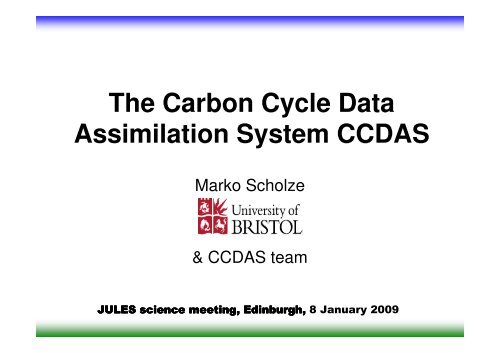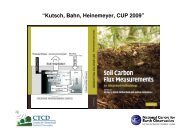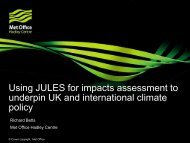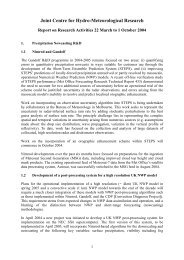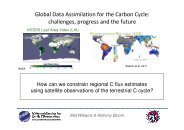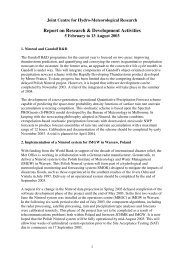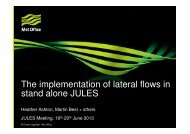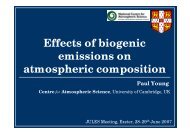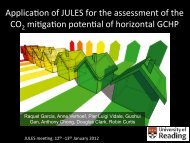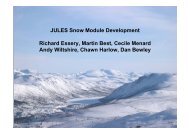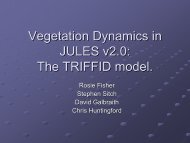The Carbon Cycle Data Assimilation System CCDAS - JULES
The Carbon Cycle Data Assimilation System CCDAS - JULES
The Carbon Cycle Data Assimilation System CCDAS - JULES
You also want an ePaper? Increase the reach of your titles
YUMPU automatically turns print PDFs into web optimized ePapers that Google loves.
<strong>The</strong> <strong>Carbon</strong> <strong>Cycle</strong> <strong>Data</strong><br />
<strong>Assimilation</strong> <strong>System</strong> <strong>CCDAS</strong><br />
Marko Scholze<br />
& <strong>CCDAS</strong> team<br />
<strong>JULES</strong> science meeting, Edinburgh, 8 January 2009
„top-down“ vs. „bottom-up“<br />
net CO 2<br />
flux at the<br />
surface<br />
atm. CO 2<br />
data<br />
atmospheric<br />
inversion<br />
(Transport Model)<br />
Process Model<br />
climate and other<br />
driving data<br />
Advantages:<br />
• Fluxes consistent with<br />
atm. data<br />
• Estimation of uncertainties<br />
Disadvantages:<br />
• No process information<br />
• Depends on prior assumptions<br />
Advantages:<br />
• Process understanding<br />
-> prognostic modeling<br />
• High resolution<br />
Disadvantages:<br />
• Global validation difficult<br />
• Parameter validity
<strong>Carbon</strong> <strong>Cycle</strong> <strong>Data</strong> <strong>Assimilation</strong><br />
<strong>System</strong>s (<strong>CCDAS</strong>)<br />
Misfit to<br />
Observations<br />
Misfit 1<br />
Forward modelling:<br />
Parameters –> Misfit<br />
Adjoint model:<br />
Atmospheric Transport<br />
Model: TM2<br />
Station Conc. 6,500<br />
∂ Misfit / ∂ Parameters<br />
parameter optimization<br />
Biosphere Model:<br />
BETHY<br />
Fluxes: 800,000<br />
Parameters: 57<br />
adjoint of BETHY<br />
generated automatically<br />
using TAF (FastOpt,<br />
Hamburg)
BETHY<br />
• GPP:<br />
C3 photosynthesis – Farquhar et al. (1980)<br />
C4 photosynthesis – Collatz et al. (1992)<br />
stomata – Knorr (1997)<br />
• Plant respiration:<br />
maintenance resp. = f(N leaf<br />
, T) – Farquhar, Ryan (1991)<br />
growth resp. ~ NPP – Ryan (1991)<br />
• Soil respiration:<br />
fast/slow pool resp., temperature (Q 10<br />
formulation) and<br />
∆t=1day<br />
soil<br />
moisture dependant<br />
• <strong>Carbon</strong> balance:<br />
∆lat, ∆lon = 2 deg<br />
average NPP = b average soil resp. (at each grid point)<br />
∆t=1h<br />
∆t=1h<br />
β1: sink
• Terrestrial biosphere model<br />
BETHY (Knorr 97) delivers CO 2<br />
fluxes to atmosphere<br />
<strong>CCDAS</strong> calibration step<br />
• Uncertainty in process parameters<br />
from laboratory measurements<br />
• Global atmospheric network<br />
provides additional constraint<br />
covariance of uncertainty<br />
in priors for parameters<br />
covariance of uncertainty in<br />
measurements + model<br />
priors for parameters<br />
observed concentrations<br />
J( p ) = 1 2<br />
<br />
[ p − p <br />
0 ] T -1 <br />
C p 0<br />
[ p − p <br />
0 ]+ 1 2<br />
<br />
[ y ( p ) − y <br />
0 ] T -1 <br />
C y 0<br />
[ y ( p ) − y <br />
0 ]
1 st derivative (gradient) of<br />
<br />
J( p ) to model parameters p :<br />
−∂J( p ) ∂p<br />
<br />
yields direction of steepest<br />
descent.<br />
Gradient Method<br />
cost function<br />
J( p )<br />
2 nd derivative (Hessian)<br />
of J( p ):<br />
∂ 2 J( p ) ∂ p 2<br />
yields curvature of J.<br />
Approximates covariance of<br />
parameters.<br />
<br />
Model parameter space ( p )<br />
Figure from Tarantola, 1987
<strong>CCDAS</strong> two-step procedure for<br />
inferring diagnostics and prognostics
<strong>Data</strong> fit<br />
(Calibration mode)<br />
Rayner et al., 2005
examples:<br />
Posterior uncertainties on<br />
parameters (Hessian mode)<br />
Use inverse Hessian of objective function<br />
to approximate posterior uncertainties<br />
⎧ ⎪<br />
C p<br />
≈ ∂2 J <br />
⎨<br />
⎩ ⎪<br />
( p ) opt<br />
2<br />
∂p i, j<br />
first guess optimized prior unc. opt.unc. Vm(TrEv) Vm(EvCn) Vm(C3Gr) Vm(Crop)<br />
µmol/m 2 s µmol/m 2 s % %<br />
error covariance<br />
Vm(TrEv) 60.0 43.2 20.0 10.5 0.28 0.02 -0.02 0.05<br />
Vm(EvCn) 29.0 32.6 20.0 16.2 0.02 0.65 -0.10 0.08<br />
Vm(C3Gr) 42.0 18.0 20.0 16.9 -0.02 -0.10 0.71 -0.31<br />
Vm(Crop) 117.0 45.4 20.0 17.8 0.05 0.08 -0.31 0.80<br />
⎫ ⎪<br />
⎬<br />
⎭ ⎪<br />
−1<br />
Relative Error Reduction 1–σ opt<br />
/σ prior<br />
Rayner et al., 2005
Net C fluxes and their uncertainties<br />
(<strong>CCDAS</strong> diagnostic mode)<br />
⎛<br />
C y<br />
= ∂y ( i<br />
p opt<br />
) ⎞<br />
⎜<br />
⎝ ∂p<br />
⎟ C ⎛ ∂y i<br />
( p <br />
opt<br />
) ⎞<br />
p⎜<br />
j ⎠ ⎝ ∂p<br />
⎟<br />
j ⎠<br />
T<br />
latitude N<br />
Examples for diagnostics:<br />
• Long term mean fluxes to atmosphere<br />
(gC/m 2 /year) and uncertainties<br />
• Regional means<br />
Rayner et al., 2005
<strong>CCDAS</strong> prognostic mode<br />
here hindcasting 2000-2003<br />
CO 2 concentration at Mauna Loa<br />
Regional carbon balances<br />
Fossil fuel emissions kept at 2000 level<br />
Scholze et al., 2007
<strong>CCDAS</strong> application: network design<br />
Construction of an interactive tool that, for a given network and a<br />
given target quantity, can approximate the uncertainty with which<br />
the value of the target quantity is constrained by the observations.<br />
<strong>CCDAS</strong> is central modelling tool in a network designer (EU FP6 funded,<br />
more info on www.imecc.ccdas.org)
<strong>CCDAS</strong> extension to include remotely<br />
sensed vegetation activity (FAPAR) as<br />
additional constraint<br />
Assess the impact of remote sensing products in terms of reducing<br />
uncertainties of the terrestrial contribution to the global carbon cycle<br />
(ESA funded, more info on www.rs.ccdas.org).
Simultaneous <strong>Assimilation</strong> at all 6 sites<br />
MERIS FAPAR + Flux data<br />
Reduction of uncertainty in<br />
process parameters<br />
0.0: no reduction of unc.<br />
0.5: unc. reduced to 50%
<strong>CCDAS</strong> extension to include a prognostic<br />
fire model<br />
• FIreStatiSticaL emIssioNs Global model (FISSLING) developed within<br />
<strong>CCDAS</strong>, based on GlobFIRM<br />
• Calculates burnt area and carbon emissions on monthly time scale<br />
• 13 additional control parameters: combustion completeness per PFT<br />
• Burnt area compares well against observations, however, emissions<br />
still need some more work<br />
Kelley, MSc thesis, 2008
<strong>CCDAS</strong> extension to include a model of<br />
seasonal fossil fuel emission<br />
• Annual fossil fuel emissions from CDIAC distributed over 5<br />
regions according to population density<br />
• Latitudinal dependant seasonal cycle imposed upon base level<br />
• Seasonal amplitude per region is control parameter<br />
Hooker-Stroud, MSc thesis, 2008
<strong>CCDAS</strong> extension to include a model of<br />
seasonal fossil fuel emission<br />
Fit to data Mauna Loa<br />
• Reduced χ-square improved with ff-model (2.23 vs 1.73)<br />
• In optimisation with ff-model parameters related to GPP changed<br />
most as compared to standard <strong>CCDAS</strong><br />
Hooker-Stroud, MSc thesis, 2008
<strong>CCDAS</strong> extension to include column<br />
integrated CO 2 data as additional constraint<br />
CO2 Flask<br />
CO2<br />
ASCOPE<br />
Sampling<br />
XCO2<br />
TM2/TM3 Jacobian<br />
TM3<br />
Surface Fluxes<br />
BETHY + background fluxes<br />
Process Parameters<br />
Demonstration study for the design of the European Space Agency’s<br />
candidate Earth Explorer mission A-SCOPE, which will provide<br />
column-integrated CO 2<br />
concentration data (ESA funded).
Summary<br />
• <strong>CCDAS</strong> tests a given combination of observational<br />
data + model formulation with uncertain parameters<br />
• <strong>CCDAS</strong> delivers optimal parameters, diagnostics, and<br />
their posterior uncertainties<br />
• <strong>CCDAS</strong> builds the core of a network design tool<br />
• More processes in <strong>CCDAS</strong>: fire & seasonal fossil fuel<br />
• More data for <strong>CCDAS</strong>:<br />
– Remotely sensed vegetation activity (FAPAR)<br />
– CO 2 fluxes from eddy flux towers<br />
– satellite CO 2 columns (also network design)


